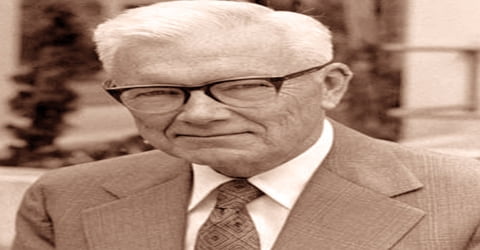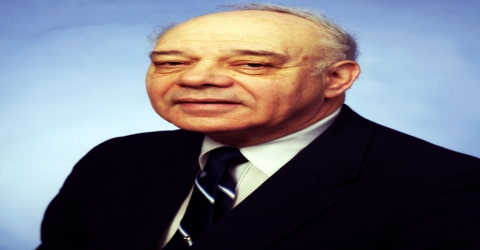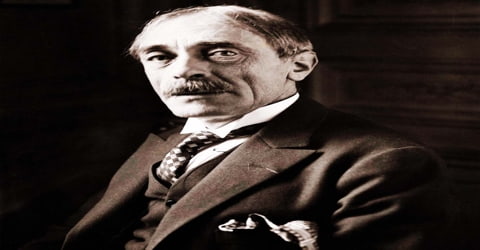Biography of Paul Flory
Paul Flory – American chemist.
Name: Paul John Flory
Date of Birth: June 19, 1910
Place of Birth: Sterling, Illinois, United States
Date of Death: September 9, 1985 (aged 75)
Place of Death: Big Sur, California, United States
Occupation: Chemist
Father: Ezra Flory
Mother: Martha Brumbaugh Flory
Spouse/Ex: Emily Catherine (m. 1936)
Children: Susan Flory Springer, Melinda Flory Groom and son John Flory, Jr.
Early Life
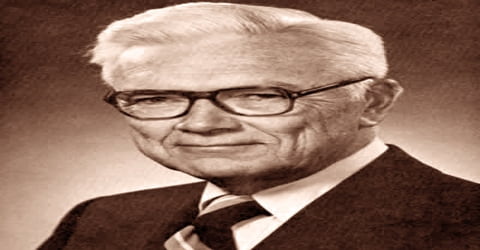
An American polymer chemist who was awarded the 1974 Nobel Prize for Chemistry “for his fundamental achievements, both theoretical and experimental, in the physical chemistry of macromolecules”, Paul Flory was born on 19th June 1910 in Sterling, Illinois, U.S. the son of Ezra Flory, a minister in the Church of the Brethren, and Martha Flory (née Brumburgh), a former schoolteacher. He was an American chemist and Nobel laureate who was known for his work in the field of polymers, or macromolecules. He was a leading pioneer in understanding the behavior of polymers in solution.
Paul Flory was most reputed for his pioneering contributions in the field of polymers or macromolecules. His leading-edge scientific work in comprehending the behavior of polymers in solution won him the prestigious ‘Nobel Prize in Chemistry’ in 1974 “for his fundamental achievements, both theoretical and experimental, in the physical chemistry of macromolecules”. He examined properties of polymers and made significant contributions in comprehending solution thermodynamics, hydrodynamics, molar mass distribution, glass formation, crystallization, melt viscosity, elasticity and chain conformation. He found that the growth of an increasing polymeric chain can stop if it reacts with other molecules that are present and in that case, it initiates a new chain. The theory of polymer networks was developed by him to elucidate the method of gelation. Later he also developed a theory of anisotropic solutions and a theory of rubber networks. Post-retirement he worked in Eastern Europe and the Soviet Union as a human rights advocate. He served in academic institutions as well as in the industrial sector and he was immensely interested both in the theory of macromolecule as also in its practical uses. He received many awards apart from ‘Nobel Prize’ which included ‘Charles Goodyear Medal’ (1968), ‘Priestley Medal’ (1974) and the ‘National Medal of Science’ (1974).
Childhood, Family and Educational Life
Paul Flory, in full Paul John Flory, was born on June 19, 1910, in Sterling, Illinois, the U.S. His father, Ezra Flory was a clergyman-educator while his mother, Martha Brumbaugh Flory was a school teacher. He had two step-sisters, Margaret and Miriam, and one younger brother James.
Paul Flory studied at ‘Elgin High School’ in Elgin, Illinois from where he completed his graduation in 1927. Thereafter he enrolled at ‘Manchester College’ (presently ‘Manchester University’), a Brethren liberal arts college in North Manchester, from where he earned a BS in Chemistry in 1931. It is here that his interest in science, especially chemistry was infused by an exceptional professor, Carl W. Holl.
Flory took his master’s degree in 1932 at a leading university, in his case Ohio State University in Columbus, Ohio. He then took a Ph.D. under Professor Herrick Johnston with a dissertation on the photochemical dissociation of nitric oxide. When Flory completed his doctorate in 1934, during the Great Depression, he was fortunate to be offered a position at du Pont’s Experimental Station by the director of the organic chemistry section, Arthur Tanberg. His first position was at DuPont with Wallace Carothers.
Personal Life
In 1936 Paul John Flory married Emily Catherine Tabor, a member of a well-established Philadelphia family. Their marriage was very successful, and Emily was a major force behind Flory’s burgeoning career. She enabled Flory to shake off his rural background and become a sophisticated international scientist.
They had three children: Susan Flory, Melinda Flory, and Paul John Flory Jr. (known as John), who became a research scientist in genetics at the Yale University School of Medicine.
Career and Works
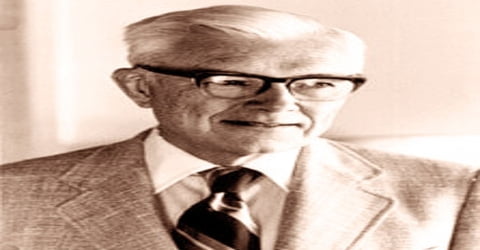
In July 1934, Paul Flory started to work in the Central Research Department of E.I. du Pont de Nemours and Company under American chemist Wallace Hume Carothers. Carothers had just completed his pathbreaking studies of condensation polymerization, which were widely regarded as definitive proof of the existence of the gigantic long-chain molecules that had been proposed by the German chemist Hermann Staudinger in the 1920s. It was Flory’s task to study the physical chemistry of such macromolecules (or polymers), a subject that would grow into his lifelong occupation.
Paul Flory’s earliest work in polymer science was in the area of polymerization kinetics at the DuPont Experimental Station. In condensation polymerization, he challenged the assumption that the reactivity of the end group decreased as the macromolecule grew, and by arguing that the reactivity was independent of the size, he was able to derive the result that the number of chains presents decreased with size exponentially. In addition polymerization, he introduced the important concept of chain transfer to improve the kinetic equations and remove difficulties in understanding the polymer size distribution.
Following Dr. Carothers’s death in 1937, Flory started working at the ‘Basic Science Research Laboratory’ at the ‘University of Cincinnati’ from 1938. While serving there for two years he developed the theory of polymer networks to elucidate the method of gelation. During that tenure, he also developed a mathematical theory for polymerization of those compounds that consist of more than two functional groups.
Flory developed a mathematical “network” theory which showed that gelation occurred at a specific “gel point.” He thus showed that gelation is mathematically similar to the kinetics of explosions or nuclear chain reactions. Carothers had been interested in the kinetics of gelation but had lacked the mathematical background to explore the process properly.
In 1940 he went to work at the laboratories of the Standard Oil Company (New Jersey) in Linden, N.J.; work at the Goodyear Tire & Rubber Company in Akron, Ohio, followed in 1943. The rubber firm Goodyear set up a fundamental research group at its Akron, Ohio, headquarters in 1943 and invited Flory to lead it. With Norman Rabjohn, he now applied his network theory to the physical properties of rubber, relating, for instance, the degree of crosslinking to the tensile strength. Flory also began his study of the crystallization of polymers and the factors that influenced this process, a line of research that was to lead him a decade later to the study of liquid crystals.
Flory introduced the concept of excluded volume, coined by Werner Kuhn in 1934, to polymers. Excluded volume refers to the idea that one part of a long chain molecule cannot occupy space that is already occupied by another part of the same molecule. Excluded volume causes the ends of a polymer chain in a solution to be further apart (on average) than they would be were there no excluded volume. The recognition that excluded volume was an important factor in analyzing long-chain molecules in solutions provided an important conceptual breakthrough and led to the explanation of several puzzling experimental results of the day. It also led to the concept of the theta point, the set of conditions at which an experiment can be conducted that causes the excluded volume effect to be neutralized. At the theta point, the chain reverts to ideal chain characteristics the long-range interactions arising from the excluded volume are eliminated, allowing the experimenter to more easily measure short-range features such as structural geometry, bond rotation potentials, and steric interactions between near-neighboring groups. Flory correctly identified that the chain dimension in polymer melts would have the size computed for a chain in an ideal solution if excluded volume interactions were neutralized by experimenting at the theta point. Among his accomplishments are an original method for computing the probable size of a polymer in a good solution, the Flory-Huggins Solution Theory, and the derivation of the Flory exponent, which helps characterize the movement of polymers in solution.
In 1948 Flory accepted a lectureship in chemistry at Cornell University in Ithaca, N.Y., a position that turned into a full professorship the same year. After several productive years at Cornell, Flory became executive director of research at the Mellon Institute in Pittsburgh in 1957, a post that he left four years later for Stanford University in California. Flory became emeritus in 1975.
In 1953 his chef-d’oeuvre ‘Principles of Polymer Chemistry’, an elaborated and refined version of his Baker Lectures was published by ‘Cornell University Press’, which soon established itself as a standard text in the field of polymers and is used broadly till present. Flory applied the concept of ‘excluded volume’ to polymers molecules, which was introduced by Swiss physical chemist Werner Kuhn in 1934. The concept elucidates that it is not possible for one of the parts of a long chain molecule to occupy a space which is already taken up by the molecule’s another part. One of his significant accomplishments was the ‘Flory-Huggins Solution Theory’ an original procedure to calculate the apparent size of a polymer in a good solution. He also deduced the ‘Flory exponent’ that aids in distinguishing polymer movements in solution.
In the mid-1950s the Mellon Institute in Pittsburgh which had hitherto acted mainly as a research service for industry decided to concentrate on basic and fundamental research. Paul Mellon and his board invited Flory (who was already a member of the board of trustees) to become its executive director in 1957. Flory’s collaborator, Thomas Fox, became manager of polymer research and stayed on after Flory departed for Stanford University four years later. During his period at the Mellon Institute, Flory published a seminal paper, “Theory of Light Scattering by Polymer Solutions” (1958), with Arthur Bueche, carried out considerable work on elasticity with Cor Hoeve and Alberto Ciferri, and continued his research on polyelectrolytes with Thomas Orofino. However, the reform program did not go according to the agreed plan, and Flory did not see eye to eye with Paul Mellon.
From 1961 to 1966 Flory served as Professor of Chemistry at the ‘Stanford University’ following which he became Jackson-Wood Professor of Chemistry at the university and served the position till his retirement in 1975. He led an active life post-retirement that saw him consulting ‘DuPont’ and ‘IBM’ for quite a while. He fought for the scientists who were oppressed, particularly in the Soviet Union and remained an advocate of the ‘Committee of Concerned Scientists’ and ‘Scientists for Sakharov, Orlov, and Shcharansky’ (SOS). In this pursuit, he often spoke on the ‘Voice of America’ broadcast to the Eastern Europe and the Soviet Union.
Flory was awarded the Nobel Prize in 1974 for “his fundamental achievements, both theoretical and experimental, in the physical chemistry of macromolecules.” While this accolade was well deserved, the award of the prize to Flory alone could also be considered controversial, as he was only one of a number of chemists who had developed the physical chemistry of polymers. By 1974 Werner Kuhn and Peter Debye had died, but Hermann Mark and Maurice Huggins were still alive, and there were other chemists of Flory’s generation including Eugene Guth and Walter Stockmayer who had made major contributions to this field. With hindsight, it must surely be regretted that this prize for the physical chemistry of polymers was not awarded jointly to Mark.
From 1979 to 1984 Flory worked for the ‘Committee on Human Rights’ of the ‘National Academy of Sciences’ and also remained a delegate at the Scientific Forum held in Hamburg in 1980.
Flory was an ardent advocate for including the subject in undergraduate curricula, where many polymer chemists felt it continued to be underrepresented in spite of the field’s enormous practical importance. Flory was a consultant to International Business Machines and DuPont for many years and filed 20 patents. His scientific output included more than 300 publications, and he was bestowed with numerous scientific awards. Two of his other notable books include ‘Statistical Mechanics of Chain Molecules’ published in January 1969 and ‘Selected Works of Paul J. Flory’ published in 1985.
Awards and Honor
Paul John Flory was awarded the Nobel Prize in Chemistry in 1974 “for his fundamental achievements, both theoretical and experimental, in the physical chemistry of macromolecules.”
Death and Legacy
On September 9, 1985, Paul John Flory succumbed to a heart attack in his weekend home in Big Sur, California, at the age of 75.
Paul Flory was a hard-working and driven individual who was described by Johnson as “a human dynamo.” He expected similar high standards from those who worked with him but also filled his students with a passion for doing science. His rather puritanical personality was balanced by his sense of humor and his loyalty to his friends.
After receiving the Nobel Prize, Flory decided to mobilize his public visibility in the battle for the human rights of oppressed scientists, especially in the Soviet Union. Flory was a prime mover in Scientists for Sakharov, Orlov, and Shcharansky (SOS) and the Committee of Concerned Scientists. He often visited dissident scientists and spoke frequently on the Voice of America broadcast to the Soviet Union and Eastern Europe. Much of the background reading and preparation for these activities was done by his wife, née Emily Tabor, whom he had married in 1936. They had three children, all of whom majored in science.
In 2002 Paul Flory was inducted into the prestigious ‘Hall of Fame’ of ‘Alpha Chi Sigma’ posthumously.
Information Source:
